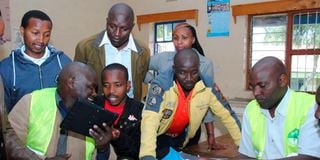Premium
Election tech under spotlight as Kenya prepares to vote

IEBC officials train the clerks on how to use the Kenya Integrated Elections Management System (KIEMS) kits at Molo Secondary on October 22, 2017.
What you need to know:
- Voting technology was introduced in Kenya to build trust and credibility around elections - but has sometimes had the opposite effect.
- Election officials say backup kits have been provided, and polling officers can fall back on manual methods, like a paper voter registry, as a last resort.
Voting technology was introduced in Kenya to build trust and credibility around elections -- but has sometimes had the opposite effect.
Here's what to know as Kenya's votes on August 9:
Fingerprints and photographs
After the death of more than 1,100 people in violence after the 2007 election, technology was proposed as a way of bolstering transparency around polls and reducing the delay in announcing results, a major source of tension.
In the subsequent 2013 and 2017 elections, results were transmitted electronically, and biometrics were used to register voters and identify them on polling day.
Biometric voter registration has been a success, boosting the electoral roll from 14.3 million in 2013 to 19.6 million in 2017 and 22.1 million in 2022.
On election day, voters provide their fingerprints for identification against a digital database, before casting their ballot in a traditional manner using a pen and paper.
Technology comes into play again when polling stations close and votes are counted.
To limit the possibility of fraud, the official form displaying the outcome from each polling station will be photographed and transmitted digitally, instead of officials inputting the results manually as was the case in 2017.
The photographs are pooled at a constituency level, then forwarded to a national tally centre, where they are cross-checked against the original forms which are physically transported.
Chequered history
Kenya's first stab at using voting technology in 2013 was not a success -- the system broadly failed, forcing the election commission to return to manual methods.
The fiasco damaged public trust in electoral technology. The opposition, led by Raila Odinga, said it was a deliberate act of sabotage by Uhuru Kenyatta, his presidential rival who won the vote.
During the next election in 2017, the biometric systems worked without a hitch, but problems in delivering the results electronically formed the basis of Odinga's successful legal challenge to Kenyatta's re-election.
The Odinga camp claimed, again, that technology had been manipulated to favour the incumbent.
OT-Morpho, the French company that supplied the voting systems, denied any manipulation or hacking had occurred.
But in a landmark ruling, Kenya's highest court, citing irregularities in the transmission of results, invalidated Kenyatta's victory and ordered a fresh vote.
An observation mission deployed by the European Union to monitor the vote noted an "improved use of technology, but insufficient capacity or security testing".
'Grey area'
When the Independent Electoral and Boundaries Commission (IEBC) ran a test in June, less than half of the 2,900 polling stations successfully transmitted results.
Another rehearsal in July, across a reduced number of locations, saw a 92 per cent rate, but the outcome didn't inspire confidence.
"We have 46,233 polling stations... So that's still a grey area. We don't know with certainty that the system of transmission will work 100 per cent," said Mulle Musau from the Elections Observation Group, a Kenyan poll watchdog.
This year, nearly 1,300 polling stations are in areas with little to no internet coverage, an improvement from the last election when 11,000 locations were in the dark.
The IEBC says results will be transmitted from these locations by satellite, and that precautions are in place to avoid any failure.
More than 55,000 electronic machines used for identifying voters and sending results have been deployed across the country, and each is powered by two stand-alone batteries.
"It requires internet only when it is transmitting results. It is offline. It cannot be hacked," said Justus Nyang'aya, an IEBC official.
Election officials say backup kits have been provided, and polling officers can fall back on manual methods, like a paper voter registry, as a last resort.
Distrust and disinformation
"Technology has made our elections much more complex, much more unclear and therefore opaque," Musau said.
"When they (voters) feel things are clouded... that is what becomes very dangerous. The biggest problem with our Kenyan elections is one word: trust."
British firm Smartmatic, which replaced OT-Morpho as the software provider for this election, has denied criticism that its technology -- used in polls from Uganda to Venezuela and the Philippines -- has flaws.
"Unfortunately, election processes, in general, are vulnerable to disinformation. Bad actors systematically disseminate lies to undermine elections by inciting fear, anxiety and distrust among voters and stakeholders," a Smartmatic spokeswoman, Samira Saba, told AFP by email.
Episodes of criminality involving electoral technology have undermined public confidence in the security and reliability of these systems.
In June, electoral officials said about one million voters had had their constituencies switched without their knowledge on the national database.
The changes had been reversed on the registry and three electoral officers were arrested, officials said, but the episode did not allay fears about the perceived opacity of these technologies.





